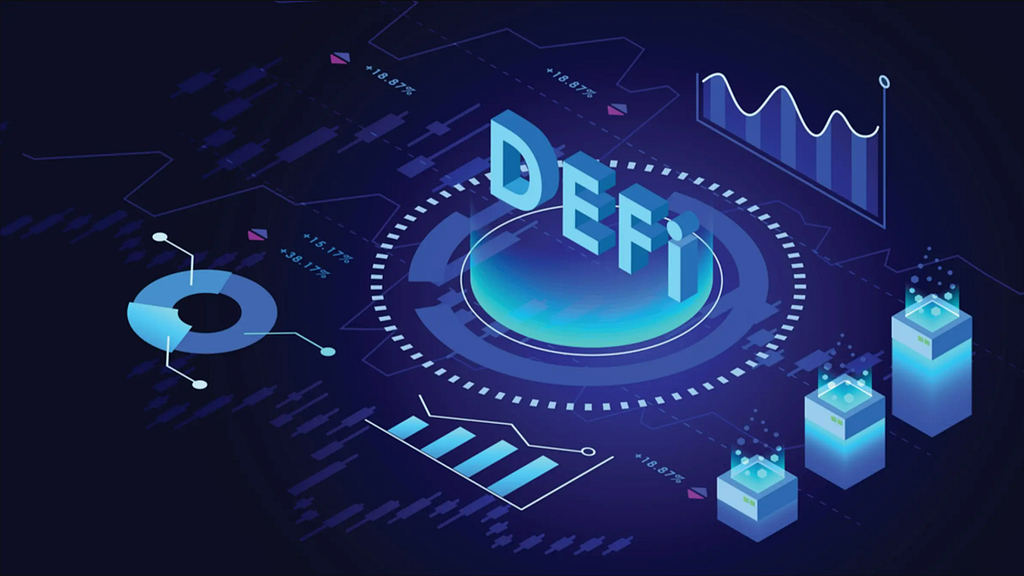Understanding DeFi: The Foundation Expanded

Building Blocks Deep Dive
Blockchain Networks
Ethereum: The grandfather of DeFi, where gas fees can hit $100+ during peak times, but Layer 2 solutions like Arbitrum cut this to mere centsSolana: The speed demon, processing transactions in seconds for fractions of a penny, though occasional network hiccups occurAvalanche: The happy medium, offering Ethereum compatibility with faster finality and lower feesBNB Chain: The centralized-yet-practical option, perfect for beginners due to low fees and simple interfacesSmart Contracts
Think of them as unbiased robot bankers that never sleep — when you deposit 1 ETH as collateral, they’ll never “forget” or “lose” your depositReal example: Uniswap’s smart contract processes over $1 billion in daily trades without a single human intermediaryDigital Assets
Beyond basic cryptocurrencies: Synthetic assets now let you trade anything from Tesla stock to gold on the blockchainWrapped tokens: Like WBTC, bringing Bitcoin’s value to Ethereum’s functionalityAMM Magic: The Math Behind the Money
How AMMs Really Work
The famous x * y = k formula in action: When you buy 10% of the ETH in a pool, the price increases by roughly 11.11% — this mathematical certainty protects against manipulationSlippage example: Trading $10,000 worth of ETH on a $100,000 liquidity pool will cause roughly a 10% price impact, while the same trade on a $10M pool causes only 0.1% impactEcosystem Components: Understanding the terms
Liquidity Pools
Real numbers: Providing $10,000 in liquidity to a popular ETH/USDC pool might earn you $20–50 daily in fees during high volatilityStrategy tip: The highest APY pools often carry hidden risks — the LUNA/UST pool offered 20% APY right before both tokens crashed to zeroLending and Borrowing
Overcollateralization explained: Depositing $15,000 worth of ETH typically allows you to borrow up to $10,000 in stablecoinsPro move: Use borrowed stablecoins to provide liquidity in other pools, creating a leverage strategyYield Farming
Example strategy: Deposit USDC-ETH LP tokens into a yield aggregator like Yearn, which auto-compounds rewards and hunts for the best yieldsReal returns: A balanced farming portfolio might yield 15–40% APY with moderate riskTECHNICAL UNDERSTANDING AND IMPLEMENTATION
1. Smart Contract Foundations
What it is: Self-executing code that automatically enforces and executes agreements.
Every DeFi journey starts with understanding basic token interactions. Here’s the fundamental interface that powers most DeFi tokens:
// The basic building block of DeFi: ERC20 Interfaceinterface IERC20 {
function transfer(address recipient, uint256 amount) external returns (bool);
function approve(address spender, uint256 amount) external returns (bool);
function transferFrom(address sender, address recipient, uint256 amount) external returns (bool);
function balanceOf(address account) external view returns (uint256);
}
Before interacting with any DeFi protocol, you’ll need to approve it to spend your tokens:
// Frontend interaction with Web3async function approveSpending(tokenAddress, spenderAddress, amount) {
const token = new ethers.Contract(tokenAddress, IERC20_ABI, signer);
const tx = await token.approve(spenderAddress, amount);
await tx.wait();
console.log('Approval successful');
}
2. AMM Deep Dive: The Math Behind Liquidity
What it is: A system that automatically determines asset prices using mathematical formulas instead of traditional order books.
Key concepts:
Constant Product Formula: x * y = kLiquidity PoolsPrice SlippageWhen you see those sweet APY numbers on AMMs, here’s what’s actually happening under the hood:
contract LiquidityPool {// Track token reserves
uint256 public reserve0;
uint256 public reserve1;
function getSwapAmount(uint256 amountIn, uint256 reserveIn, uint256 reserveOut)
public pure returns (uint256 amountOut)
{
// Famous constant product formula
// k = x * y remains constant
uint256 amountInWithFee = amountIn * 997; // 0.3% fee
uint256 numerator = amountInWithFee * reserveOut;
uint256 denominator = (reserveIn * 1000) + amountInWithFee;
return numerator / denominator;
}
}
3. Yield Farming Implementation
What it is: Strategy of providing liquidity or lending assets to earn returns (yield) in the form of additional tokens.
Types of yield:
Trading feesInterest from lendingReward tokensGovernance tokensHere’s how those juicy yield farms actually work:
contract YieldFarm {// Reward rate per second
uint256 public rewardRate = 100;
mapping(address => uint256) public userStakeTime;
mapping(address => uint256) public balances;
function stake(uint256 amount) external {
require(amount > 0, "Cannot stake 0");
// Update user's balance and stake time
balances[msg.sender] += amount;
userStakeTime[msg.sender] = block.timestamp;
// Transfer tokens to contract
stakingToken.transferFrom(msg.sender, address(this), amount);
}
function calculateRewards(address user) public view returns (uint256) {
uint256 timeStaked = block.timestamp - userStakeTime[user];
return (balances[user] * timeStaked * rewardRate) / 1e18;
}
}
4. Flash Loan Opportunities
What it is: Uncollateralized loans that must be borrowed and repaid within a single transaction block.
Use cases:
ArbitrageCollateral swapsLiquidationsThe famous “free money” concept in DeFi — here’s how flash loans work:
contract FlashLoan {function executeOperation(
address[] calldata assets,
uint256[] calldata amounts,
uint256[] calldata premiums,
address initiator,
bytes calldata params
) external returns (bool) {
// 1. Receive the borrowed funds
// 2. Do something profitable (arbitrage, liquidation, etc.)
// 3. Repay loan
uint256 amountToRepay = amounts[0] + premiums[0];
IERC20(assets[0]).approve(msg.sender, amountToRepay);
return true;
}
}
5. Practical Portfolio Management
Here’s how to monitor your DeFi positions programmatically:
// Monitor your liquidity positionsasync function monitorPosition(poolAddress, userAddress) {
const pool = new ethers.Contract(poolAddress, POOL_ABI, provider);
// Listen for events
pool.on('Mint', async (sender, amount0, amount1, event) => {
if(sender === userAddress) {
console.log(`
Liquidity Added:
Token0: ${ethers.utils.formatEther(amount0)}
Token1: ${ethers.utils.formatEther(amount1)}
Transaction: ${event.transactionHash}
`);
}
});
}
6. Gas Optimization Techniques
What it is: Techniques to reduce transaction costs on the blockchain.
Save money on every transaction with these optimizations:
contract GasEfficient {// Pack variables to save storage slots
struct UserInfo {
uint128 balance; // Packs with lastUpdateTime
uint64 lastUpdateTime;
uint64 rewardDebt;
}
// Use mappings instead of arrays
mapping(address => UserInfo) public userInfo;
// Use events for cheap storage
event Harvest(address indexed user, uint256 amount);
// Batch operations to save gas
function batchHarvest(address[] calldata users) external {
for(uint i = 0; i < users.length; i++) {
_harvest(users[i]);
}
}
}
7. Liquidity Pool
What it is: A pool of tokens locked in a smart contract that provides trading liquidity for a decentralized exchange.
Key aspects:
Liquidity Provider (LP) tokensTrading feesImpermanent Loss riskcontract LiquidityPool {IERC20 public tokenA;
IERC20 public tokenB;
uint256 public totalShares;
mapping(address => uint256) public shares;
// Add liquidity
function addLiquidity(uint256 amountA, uint256 amountB) external {
// Transfer tokens to pool
tokenA.transferFrom(msg.sender, address(this), amountA);
tokenB.transferFrom(msg.sender, address(this), amountB);
// Calculate and mint LP tokens
uint256 share;
if (totalShares == 0) {
share = sqrt(amountA * amountB);
} else {
share = min(
(amountA * totalShares) / tokenA.balanceOf(address(this)),
(amountB * totalShares) / tokenB.balanceOf(address(this))
);
}
shares[msg.sender] += share;
totalShares += share;
}
}
The Money-Making Roadmap: Practical Steps
Phase 1: Foundation (Month 1–2)
Security first: A $100 hardware wallet protecting your $10,000 portfolio is like buying a $100 safe for your $10,000 in cashStart small: Begin with $100 in a simple ETH-USDC liquidity pool to learn the mechanics without risking muchPhase 2: Intermediate (Month 2–4)
Strategy example: Split $10,000 across three yield farms: 50% in stable pairs, 30% in ETH pairs, and 20% in higher-risk opportunitiesRisk management: Use DeFi insurance protocols like Nexus Mutual to protect against smart contract failuresPhase 3: Advanced (Month 4+)
Complex plays: Delta-neutral strategies can earn 15–30% APY while being protected against price movementsCross-chain arbitrage: Spot price differences like ETH being 1% cheaper on Arbitrum than Ethereum mainnetTechnical Implementation: Real-World Examples
Smart Contract Interaction
MetaMask tip: Always keep a small amount of native tokens (ETH, AVAX, etc.) for gas fees across different networksGas optimization: Batch multiple transactions together — combining 5 trades into one can save up to 40% on gas feesRisk Management in Practice
Smart contract risk: Use DeFi score websites to check protocol security — look for multiple audits and time-tested codeMarket risk: The infamous “IL calculator” — providing ETH-USDC liquidity during a 50% ETH price increase results in roughly 5.7% impermanent lossAdvanced Strategies That Work
Yield Optimization
Compounding math: Daily compounding of a 20% APY yield turns into 22.1% actual yield, while weekly compounds to 21.7%Gas efficiency: On Ethereum, compound rewards only when they cover at least 5x the gas feesPortfolio Management
Position sizing: Never put more than 20% of your portfolio in a single protocol, no matter how “safe” it seemsInsurance strategy: Allocate 1–2% of your portfolio to coverage for your largest positionsFuture Trends and Opportunities
Layer 2 Solutions
Transaction costs: Arbitrum and Optimism regularly offer 90–95% savings compared to Ethereum mainnetSpeed boost: Polygon processes transactions in seconds while maintaining reasonable decentralizationReal-World Asset Integration
Coming soon: Tokenized real estate letting you own $100 worth of a Manhattan skyscraperCarbon credits: Trade and offset carbon emissions directly through DeFi protocolsInstitutional Adoption
Bank participation: JPMorgan’s experiment with Aave for institutional lendingRegulatory compliance: New protocols implementing KYC and working with regulatorsGetting Started: Your First 24 Hours in DeFi
Setup checklist:
Get a hardware walletInstall MetaMaskBuy some ETH or stablecoinsLearn to bridge to Layer 2sFirst moves:
Start with simple stablecoin farmingExperience a token swap on UniswapProvide a small amount of liquidityTry lending some assetsPro Tips and Tricks
Gas Optimization
Use etherscan.io/gastracker to find the best times to transactSunday mornings (UTC) often have the lowest gas feesLayer 2s are your friend for frequent tradingSecurity Best Practices
Never share your seed phraseUse different wallets for testing and holding large amountsAlways test new protocols with small amounts firstYield Strategies
Base yield: Stablecoin lending (5–10% APY)Medium risk: Blue-chip liquidity provision (10–30% APY)High risk: New protocol farming (50%+ APY but high risk)Remember: DeFi is like a high-stakes puzzle — exciting and potentially rewarding, but requiring careful thought and constant learning. Start small, stay curious, and never invest more than you can afford to lose in this digital financial frontier.
The Complete DeFi Handbook: From Theory to Implementation was originally published in The Capital on Medium, where people are continuing the conversation by highlighting and responding to this story.


 1 week ago
1
1 week ago
1 









 Bengali (Bangladesh) ·
Bengali (Bangladesh) ·  English (United States) ·
English (United States) ·